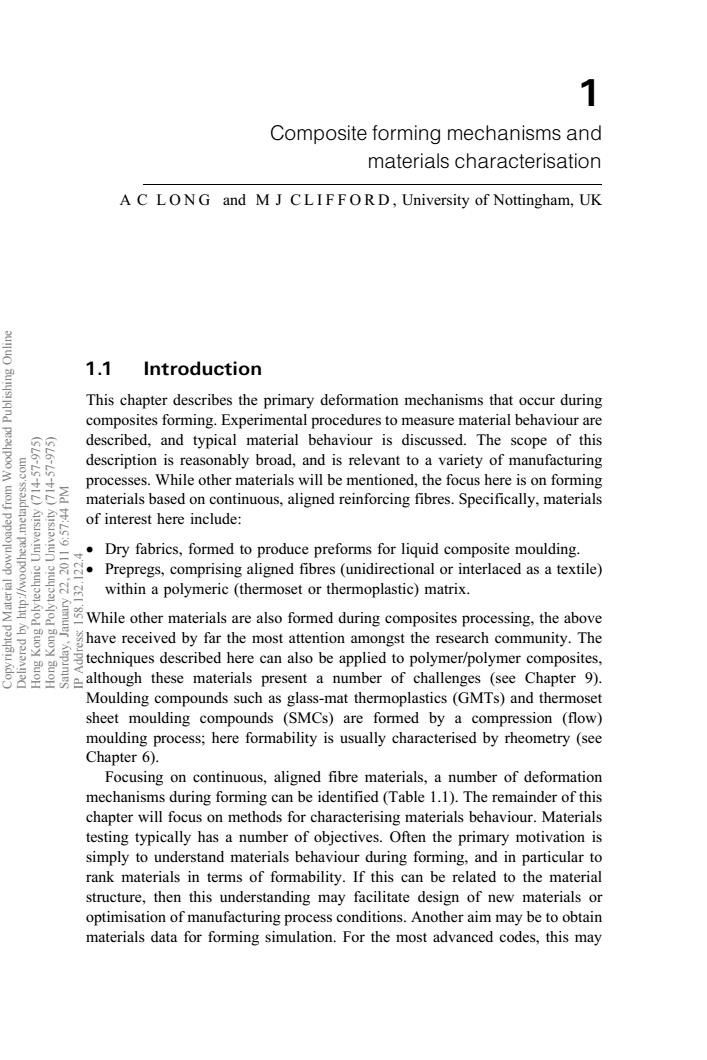正在加载图片...

1 Composite forming mechanisms and materials characterisation A C LONG and M J CLIFFORD,University of Nottingham,UK 1.1 Introduction This chapter describes the primary deformation mechanisms that occur during composites forming.Experimental procedures to measure material behaviour are described,and typical material behaviour is discussed.The scope of this poo M description is reasonably broad,and is relevant to a variety of manufacturing processes.While other materials will be mentioned,the focus here is on forming materials based on continuous,aligned reinforcing fibres.Specifically,materials of interest here include: .Dry fabrics,formed to produce preforms for liquid composite moulding. .Prepregs,comprising aligned fibres(unidirectional or interlaced as a textile) within a polymeric (thermoset or thermoplastic)matrix. While other materials are also formed during composites processing,the above have received by far the most attention amongst the research community.The techniques described here can also be applied to polymer/polymer composites, although these materials present a number of challenges (see Chapter 9). Moulding compounds such as glass-mat thermoplastics (GMTs)and thermoset sheet moulding compounds (SMCs)are formed by a compression (flow) moulding process;here formability is usually characterised by rheometry(see Chapter 6). Focusing on continuous,aligned fibre materials,a number of deformation mechanisms during forming can be identified(Table 1.1).The remainder of this chapter will focus on methods for characterising materials behaviour.Materials testing typically has a number of objectives.Often the primary motivation is simply to understand materials behaviour during forming,and in particular to rank materials in terms of formability.If this can be related to the material structure,then this understanding may facilitate design of new materials or optimisation of manufacturing process conditions.Another aim may be to obtain materials data for forming simulation.For the most advanced codes,this may1.1 Introduction This chapter describes the primary deformation mechanisms that occur during composites forming. Experimental procedures to measure material behaviour are described, and typical material behaviour is discussed. The scope of this description is reasonably broad, and is relevant to a variety of manufacturing processes. While other materials will be mentioned, the focus here is on forming materials based on continuous, aligned reinforcing fibres. Specifically, materials of interest here include: · Dry fabrics, formed to produce preforms for liquid composite moulding. · Prepregs, comprising aligned fibres (unidirectional or interlaced as a textile) within a polymeric (thermoset or thermoplastic) matrix. While other materials are also formed during composites processing, the above have received by far the most attention amongst the research community. The techniques described here can also be applied to polymer/polymer composites, although these materials present a number of challenges (see Chapter 9). Moulding compounds such as glass-mat thermoplastics (GMTs) and thermoset sheet moulding compounds (SMCs) are formed by a compression (flow) moulding process; here formability is usually characterised by rheometry (see Chapter 6). Focusing on continuous, aligned fibre materials, a number of deformation mechanisms during forming can be identified (Table 1.1). The remainder of this chapter will focus on methods for characterising materials behaviour. Materials testing typically has a number of objectives. Often the primary motivation is simply to understand materials behaviour during forming, and in particular to rank materials in terms of formability. If this can be related to the material structure, then this understanding may facilitate design of new materials or optimisation of manufacturing process conditions. Another aim may be to obtain materials data for forming simulation. For the most advanced codes, this may 1 Composite forming mechanisms and materials characterisation A C L O N G and M J C L I F F O R D , University of Nottingham, UK Copyrighted Material downloaded from Woodhead Publishing Online Delivered by http://woodhead.metapress.com Hong Kong Polytechnic University (714-57-975) Hong Kong Polytechnic University (714-57-975) Saturday, January 22, 2011 6:57:44 PM IP Address: 158.132.122.4